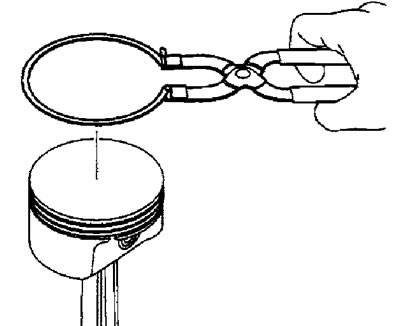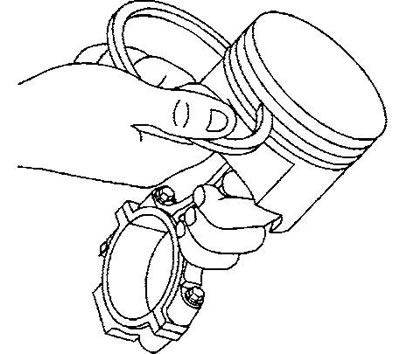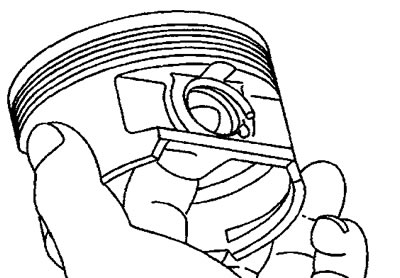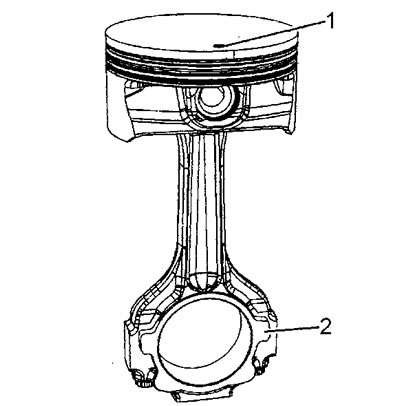Disassembly
Piston pin floating type
1. Remove the connecting rod cap and remove the connecting rod bearing shells.

2. Using a piston ring remover, remove the rings.

3. Rotate the piston pin circlip so that the ends of the ring are in the cutout (1) bosses.

4. Use a screwdriver to remove the circlip.

5. Remove the piston pin, disassemble the piston and connecting rod.

6. Combination of piston and piston pin is ensured by selective assembly, replace piston and pin only as a pair.
Press Fit Piston Pin
Attention:
- Disassembly of the piston, press fit piston pin, and connecting rod will usually damage the piston pin and piston pin bores. If the piston, pin, and connecting rod have been separated, replace the entire assembly.
- The disassembly procedure given here should be used for diagnostic purposes only.
1. Remove the connecting rod bearing shells.
2. Remove the piston rings from the piston.
3. Install the piston and connecting rod in the tool for disassembly.

4. Install the plug in the piston pin.
5. Install a drift through the yoke of the tool onto the piston pin plug
Note: The pressing pressure must not exceed 35,000 kPa to avoid breakage of the fixture.
6. Press the piston pin out of the connecting rod and piston.

Washing and checking
Attention:
- Replace pistons, pins and connecting rods that are damaged or show signs of excessive wear.
- The piston and piston pin are replaced as a pair.
- Do not clean the piston with a wire brush.
- Dimensioning of parts should be carried out at room temperature.
1. Remove varnish and carbon deposits from the piston (107) with a cleaning solvent. Wash all parts of the piston group with solvent.

2. Dry the parts of the piston group with compressed air.
3. Clean the piston ring grooves with a special cleaning tool.

4. Clean the oil supply channels to the piston bosses of the oil drain hole in the oil scraper ring groove.
5. Inspect the piston, look for:
- Cracks in the piston ring comb, skirt and piston bosses.
- Notches, nicks, or deformation of the piston ring grooves, which can cause the ring to hang.
- Minor defects can be removed with a small file.

- Traces of gas erosion in the piston head (1).
- Seizures or scratches on the piston skirt (2).
- Seizures in the hole of the bosses for installing the piston pin (3).
6. Insert the edge of the piston ring into the groove of the piston ring. Roll the piston ring around the piston groove. If the resistance to ring movement is caused by groove distortion, remove the cause of seizing with a fine file. If the resistance to movement is caused by deformation of the piston ring, replace the ring.

7. Measure the clearance between the piston groove and the ring with a flat feeler gauge. If the gap is out of tolerance (see specification), try installing a different piston ring. If the desired clearance is still not achieved, replace the piston and piston pin.

8. Measure the outer diameter of the piston pin and the inner diameter of the piston boss, determine the clearance between the piston and the piston pin. If the gap is out of tolerance (see specification), replace piston and pin.

9. Measure a backlash in the lock of a piston ring.
Warning:
- Do not file the ring to increase the gap in the lock.
- Measure the clearance in the cylinder in which the ring will be installed.

A) Install the piston ring into the cylinder approximately 6.5 mm below the ring stop at TDC. Orient the ring to the cylinder axis with the piston head upside down.
b) Measure the piston ring gap with a flat feeler gauge.

10. Inspect the connecting rod, look for:
- Signs of twisting of the connecting rod body (1).
- Signs of a mismatch between the body and the connecting rod cap (2).
- Burrs or tearing of metal in the bed of the bearing (3).
- Signs of groove damage (4) insert fixation.

Warning:
- The connecting rod and connecting rod cap are processed together, do not confuse the parts of different kits.
- The connecting rod and cap are not repairable, if defective, replace the connecting rod assembly.
- Do not attempt to re-thread the connecting rod for the cap bolts.
11. By measuring, determine the ovality of the bed of the connecting rod bearing, when the ovality goes out of tolerance (see specification) replace the connecting rod.

12. By measuring the outer diameter of the piston pin and the inner diameter of the small head of the connecting rod, determine the clearance between the connecting rod and the piston pin. If the gap is out of tolerance (see specification), replace the connecting rod or piston and pin.
13. Check the condition of the connecting rod bearing shells. See the section "checking the main bearing shells".

Measuring the outer diameter of the piston pin and the inner diameter of the small end of the connecting rod
Assembly
1. Install one piston pin circlip. Check the correct fit of the ring in the groove of the boss.

2. Assemble the piston and connecting rod. Label (1) on the piston head and lugs (2) on the connecting rod should be on one side.

3. Install the piston pin into the piston and connecting rod.
4. Install the second piston pin circlip.
Caution: When installing piston rings, always use a piston ring plier. Move the lock of the rings to the minimum required to install the ring.
5. Install the piston rings on the piston. Label (point or part number) on the piston ring must point towards the piston head. If there is no mark on the upper compression ring, the ring can be installed in any direction.
6. Separate the locks of the scrapers of the oil scraper ring at least 25 mm apart.
7. Spread the locks of the compression rings by 180°.
Note: Ring locks must not be located on the thrust side of the piston.
8. Install the connecting rod bearing shells in the connecting rod and cap.
